MERCEDES-BENZ G-Class 2012 W463 Owner's Manual
Manufacturer: MERCEDES-BENZ, Model Year: 2012, Model line: G-Class, Model: MERCEDES-BENZ G-Class 2012 W463Pages: 284, PDF Size: 9.4 MB
Page 271 of 284
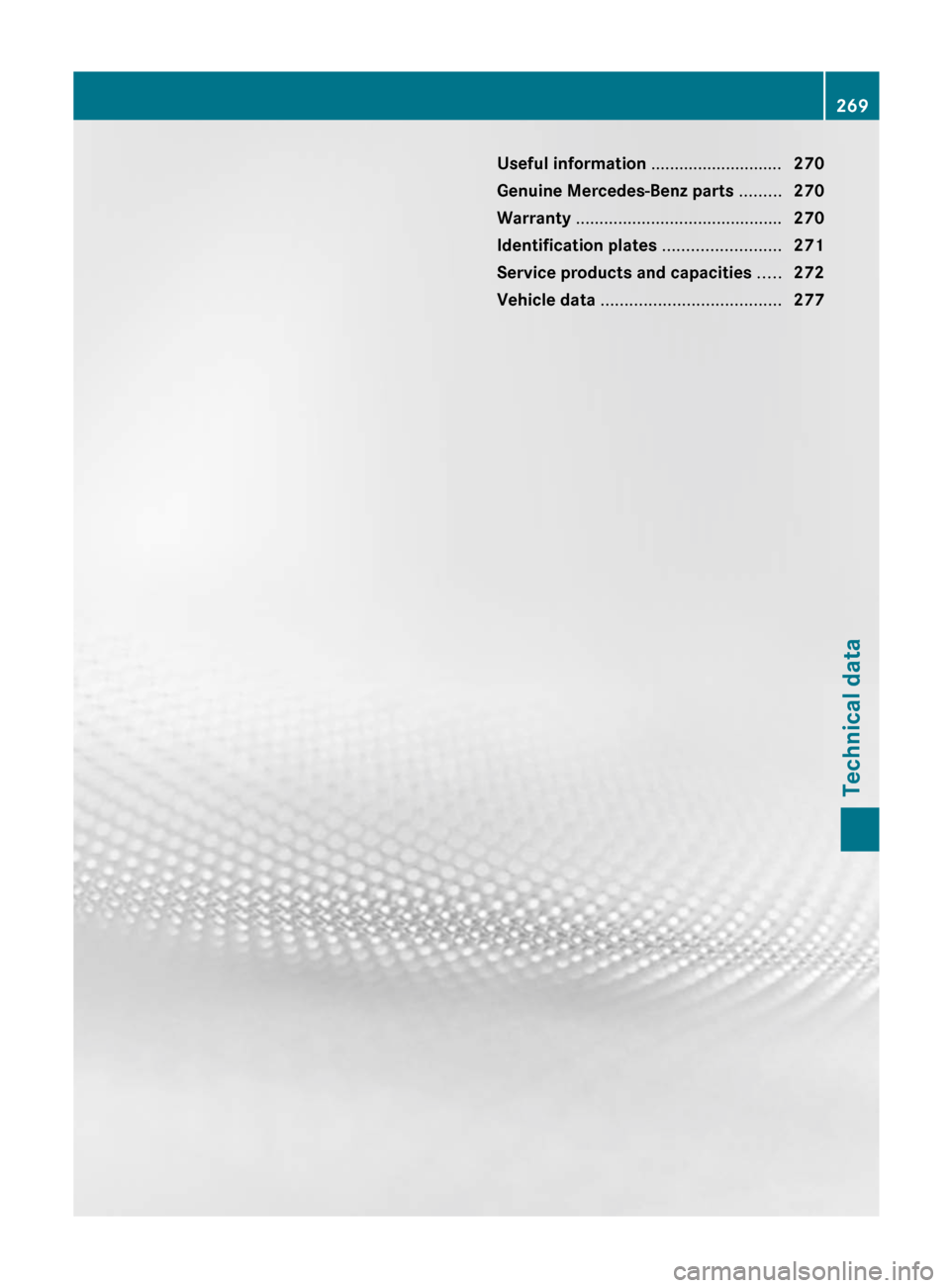
Useful information ............................
270
Genuine Mercedes-Benz parts ......... 270
Warranty ............................................ 270
Identification plates .........................271
Service products and capacities ..... 272
Vehicle data ...................................... 277 269Technical data
Page 272 of 284
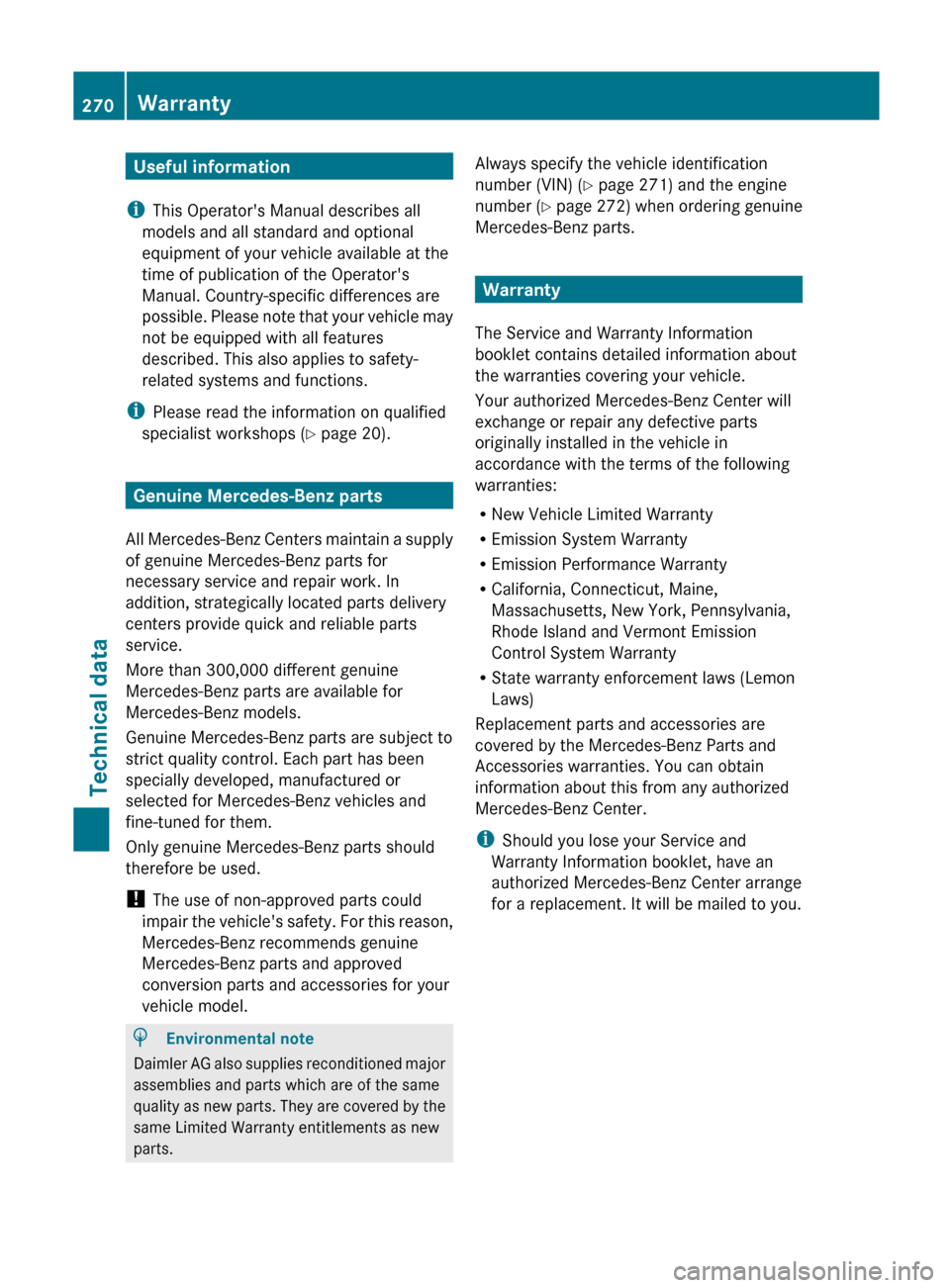
Useful information
i This Operator's Manual describes all
models and all standard and optional
equipment of your vehicle available at the
time of publication of the Operator's
Manual. Country-specific differences are
possible. Please
note that your vehicle may
not be equipped with all features
described. This also applies to safety-
related systems and functions.
i Please read the information on qualified
specialist workshops (Y page 20). Genuine Mercedes-Benz parts
All Mercedes-Benz
Centers maintain a supply
of genuine Mercedes-Benz parts for
necessary service and repair work. In
addition, strategically located parts delivery
centers provide quick and reliable parts
service.
More than 300,000 different genuine
Mercedes-Benz parts are available for
Mercedes-Benz models.
Genuine Mercedes-Benz parts are subject to
strict quality control. Each part has been
specially developed, manufactured or
selected for Mercedes-Benz vehicles and
fine-tuned for them.
Only genuine Mercedes-Benz parts should
therefore be used.
! The use of non-approved parts could
impair the vehicle's safety. For this reason,
Mercedes-Benz recommends genuine
Mercedes-Benz parts and approved
conversion parts and accessories for your
vehicle model. H
Environmental note
Daimler
AG also supplies reconditioned major
assemblies and parts which are of the same
quality as
new parts. They are covered by the
same Limited Warranty entitlements as new
parts. Always specify the vehicle identification
number (VIN) (
Y page 271) and the engine
number (
Y page 272) when ordering genuine
Mercedes-Benz parts. Warranty
The Service and Warranty Information
booklet contains detailed information about
the warranties covering your vehicle.
Your authorized Mercedes-Benz Center will
exchange or repair any defective parts
originally installed in the vehicle in
accordance with the terms of the following
warranties:
R New Vehicle Limited Warranty
R Emission System Warranty
R Emission Performance Warranty
R California, Connecticut, Maine,
Massachusetts, New York, Pennsylvania,
Rhode Island and Vermont Emission
Control System Warranty
R State warranty enforcement laws (Lemon
Laws)
Replacement parts and accessories are
covered by the Mercedes-Benz Parts and
Accessories warranties. You can obtain
information about this from any authorized
Mercedes-Benz Center.
i Should you lose your Service and
Warranty Information booklet, have an
authorized Mercedes-Benz Center arrange
for a replacement. It will be mailed to you. 270
Warranty
Technical data
Page 273 of 284
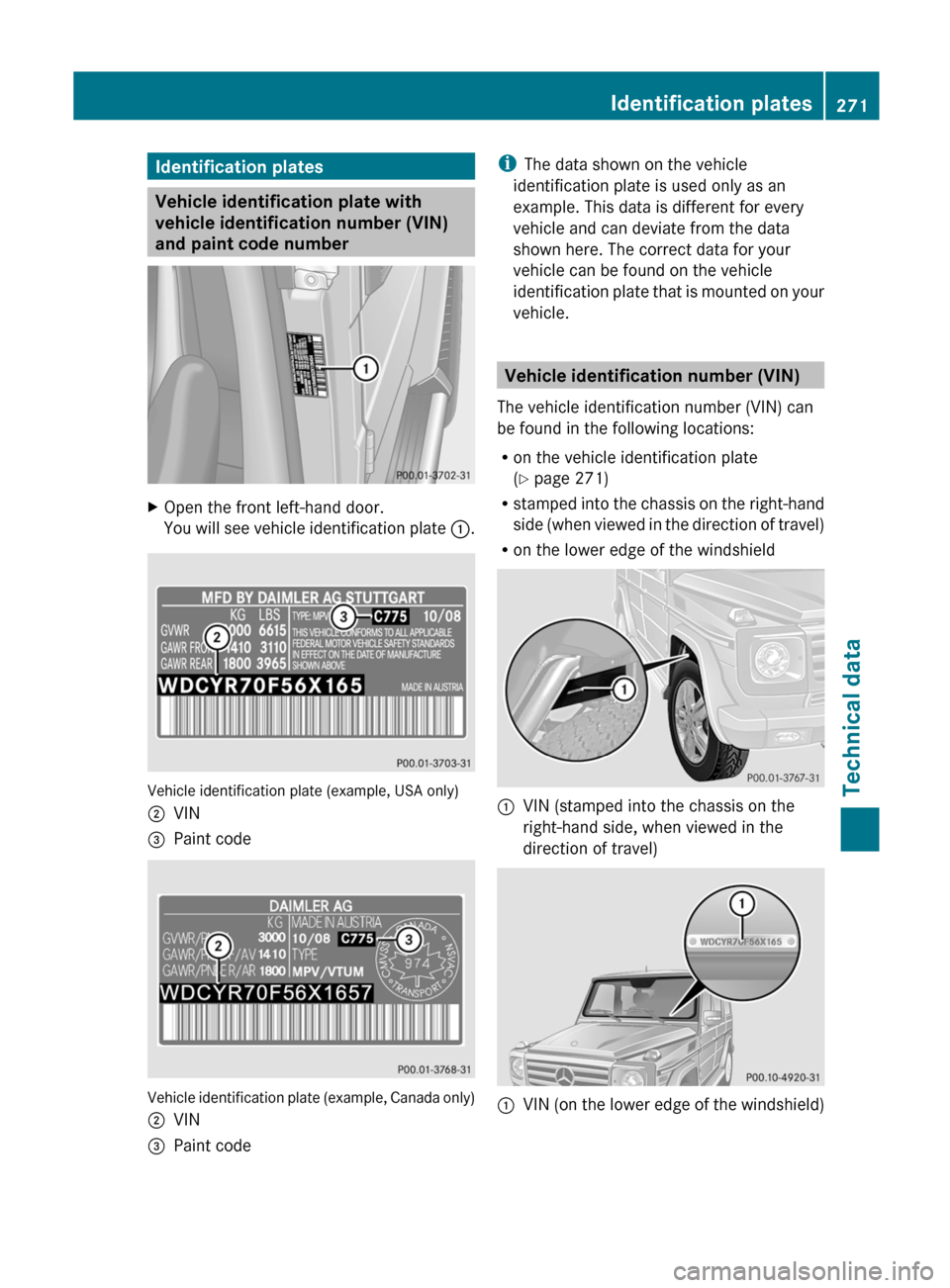
Identification plates
Vehicle identification plate with
vehicle identification number (VIN)
and paint code number
X
Open the front left-hand door.
You will
see vehicle identification plate :.Vehicle identification plate (example, USA only)
;
VIN
= Paint code Vehicle
identification plate (example, Canada only)
; VIN
= Paint code i
The data shown on the vehicle
identification plate is used only as an
example. This data is different for every
vehicle and can deviate from the data
shown here. The correct data for your
vehicle can be found on the vehicle
identification plate
that is mounted on your
vehicle. Vehicle identification number (VIN)
The vehicle identification number (VIN) can
be found in the following locations:
R on the vehicle identification plate
(
Y page 271)
R stamped into
the chassis on the right-hand
side (when viewed in the direction of travel)
R on the lower edge of the windshield :
VIN (stamped into the chassis on the
right-hand side, when viewed in the
direction of travel) :
VIN
(on the lower edge of the windshield) Identification plates
271
Technical data Z
Page 274 of 284
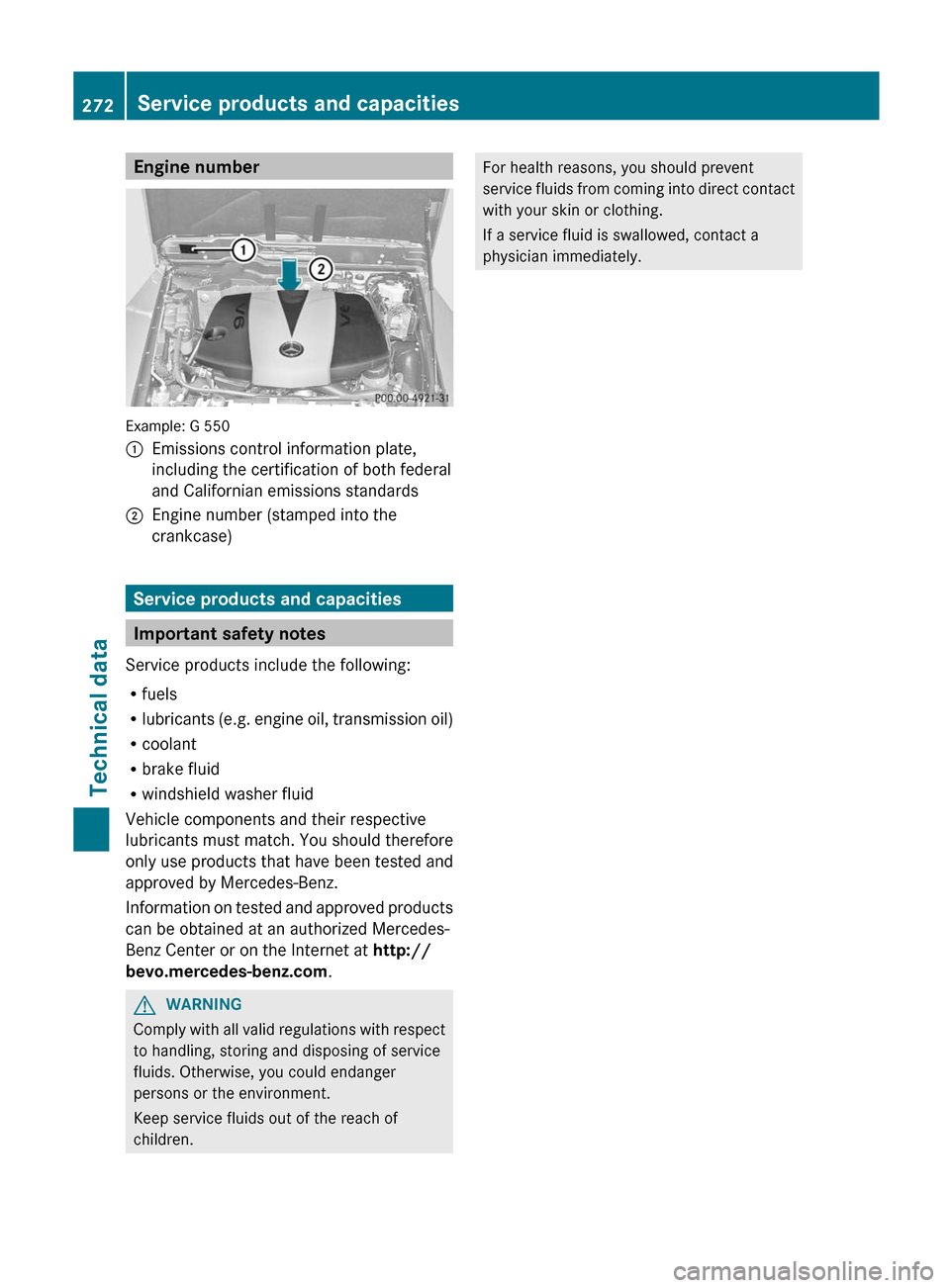
Engine number
Example: G 550
:
Emissions control information plate,
including the certification of both federal
and Californian emissions standards
; Engine number (stamped into the
crankcase) Service products and capacities
Important safety notes
Service products include the following:
R fuels
R lubricants (e.g.
engine oil, transmission oil)
R coolant
R brake fluid
R windshield washer fluid
Vehicle components and their respective
lubricants must match. You should therefore
only use products that have been tested and
approved by Mercedes-Benz.
Information on tested and approved products
can be obtained at an authorized Mercedes-
Benz Center or on the Internet at http://
bevo.mercedes-benz.com .G
WARNING
Comply
with all valid regulations with respect
to handling, storing and disposing of service
fluids. Otherwise, you could endanger
persons or the environment.
Keep service fluids out of the reach of
children. For health reasons, you should prevent
service
fluids
from coming into direct contact
with your skin or clothing.
If a service fluid is swallowed, contact a
physician immediately. 272
Service products and capacities
Technical data
Page 275 of 284

Capacities
Vehicle model Capacity Fuel, coolant,
lubricants, etc.
Engine oil and
filter
G 550 9.5 US qt (9.0 l) Approved engine
oils
G 55 AMG 9.0 US qt (8.5 l)
Power steering
All models Approx. 1.06 US qt (1.0 l) MB power steering
fluid or approved
Dexron III ATF
Cooling system
G 550 Approx. 12.8 US qt (12.1 l) MB 325.0 corrosion
inhibitor/antifreeze
agent
G 55 AMG Approx. 13.4 US qt (12.7 l)
Tank capacity
G 550 25.4 US gal (96.0 l) Unleaded gasoline
(at least 91 octane;
average value of
96 RON/86 MON)
G 55 AMG 25.1 US gal (95.0 l)
Reserve
All models Approx. 5.3 US gal (20.0 l)
Automatic
climate control
All models — Refrigerant R134a
and special PAG
lubricant (never
R12)
Windshield/
headlamp
cleaning
system
All models 7.4 US qt (7.0 l) MB windshield
washer
concentrate
21
( Y page 277)
Mixing ratio for
washer fluid
(Y page 277) Fuel
Important safety notes G
WARNING
Gasoline is highly flammable and poisonous.
It burns violently and can cause serious
personal injury.
Never allow sparks, flames or smoking
materials near gasoline.
Turn off the engine before refueling. Whenever you are around gasoline, avoid
inhaling fumes and any skin or clothing
contact.
Direct skin contact with fuels and the
inhalation
of
fuel vapors are damaging to your
health.
Premium-grade unleaded gasoline !
To ensure the longevity and full
performance of the engine, only premium-
grade unleaded gasoline may be used.
21 Mixed with water or premixed washer fluid with antifreeze protection. Service products and capacities
273
Technical data Z
Page 276 of 284
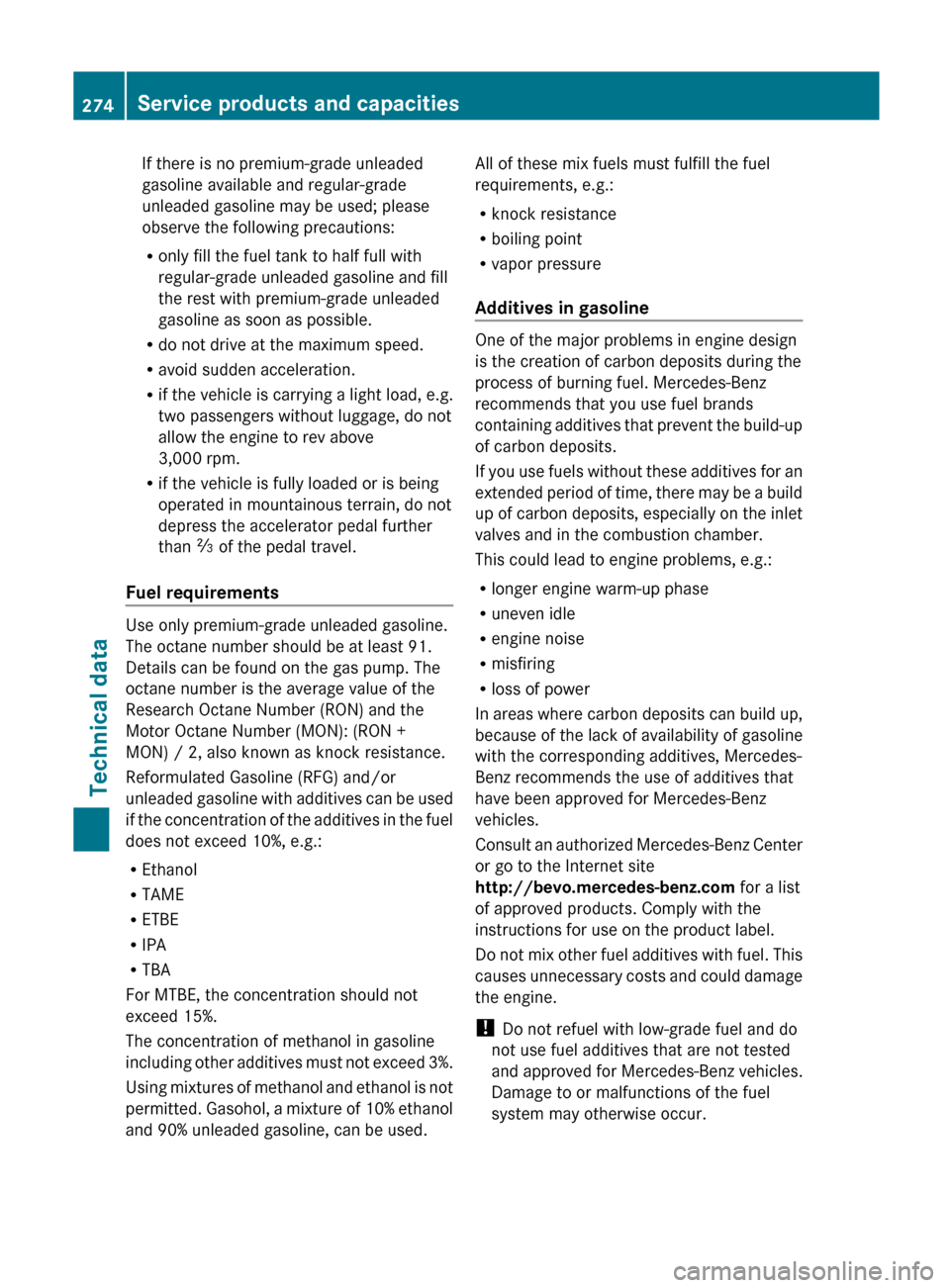
If there is no premium-grade unleaded
gasoline available and regular-grade
unleaded gasoline may be used; please
observe the following precautions:
R
only fill the fuel tank to half full with
regular-grade unleaded gasoline and fill
the rest with premium-grade unleaded
gasoline as soon as possible.
R do not drive at the maximum speed.
R avoid sudden acceleration.
R if the
vehicle is carrying a light load, e.g.
two passengers without luggage, do not
allow the engine to rev above
3,000 rpm.
R if the vehicle is fully loaded or is being
operated in mountainous terrain, do not
depress the accelerator pedal further
than Ô of the pedal travel.
Fuel requirements Use only premium-grade unleaded gasoline.
The octane number should be at least 91.
Details can be found on the gas pump. The
octane number is the average value of the
Research Octane Number (RON) and the
Motor Octane Number (MON): (RON +
MON) / 2, also known as knock resistance.
Reformulated Gasoline (RFG) and/or
unleaded
gasoline
with additives can be used
if the concentration of the additives in the fuel
does not exceed 10%, e.g.:
R Ethanol
R TAME
R ETBE
R IPA
R TBA
For MTBE, the concentration should not
exceed 15%.
The concentration of methanol in gasoline
including other additives must not exceed 3%.
Using mixtures of methanol and ethanol is not
permitted. Gasohol, a mixture of 10% ethanol
and 90% unleaded gasoline, can be used. All of these mix fuels must fulfill the fuel
requirements, e.g.:
R
knock resistance
R boiling point
R vapor pressure
Additives in gasoline One of the major problems in engine design
is the creation of carbon deposits during the
process of burning fuel. Mercedes-Benz
recommends that you use fuel brands
containing
additives
that prevent the build-up
of carbon deposits.
If you use fuels without these additives for an
extended period of time, there may be a build
up of carbon deposits, especially on the inlet
valves and in the combustion chamber.
This could lead to engine problems, e.g.:
R longer engine warm-up phase
R uneven idle
R engine noise
R misfiring
R loss of power
In areas where carbon deposits can build up,
because of the lack of availability of gasoline
with the corresponding additives, Mercedes-
Benz recommends the use of additives that
have been approved for Mercedes-Benz
vehicles.
Consult an authorized Mercedes-Benz Center
or go to the Internet site
http://bevo.mercedes-benz.com for a list
of approved products. Comply with the
instructions for use on the product label.
Do not mix other fuel additives with fuel. This
causes unnecessary costs and could damage
the engine.
! Do not refuel with low-grade fuel and do
not use fuel additives that are not tested
and approved for Mercedes-Benz vehicles.
Damage to or malfunctions of the fuel
system may otherwise occur. 274
Service products and capacities
Technical data
Page 277 of 284
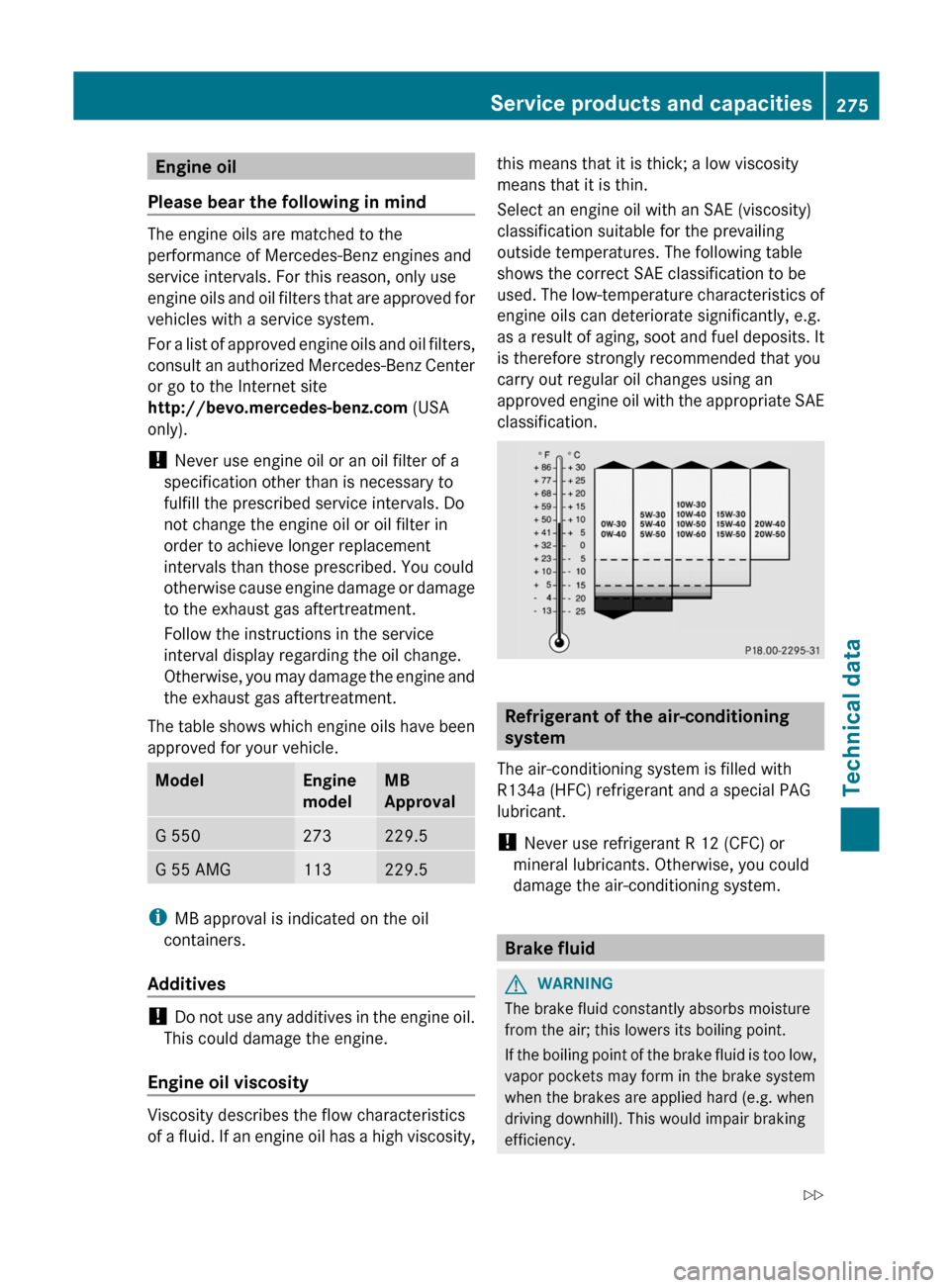
Engine oil
Please bear the following in mind The engine oils are matched to the
performance of Mercedes-Benz engines and
service intervals. For this reason, only use
engine
oils
and oil filters that are approved for
vehicles with a service system.
For a list of approved engine oils and oil filters,
consult an authorized Mercedes-Benz Center
or go to the Internet site
http://bevo.mercedes-benz.com (USA
only).
! Never use engine oil or an oil filter of a
specification other than is necessary to
fulfill the prescribed service intervals. Do
not change the engine oil or oil filter in
order to achieve longer replacement
intervals than those prescribed. You could
otherwise cause engine damage or damage
to the exhaust gas aftertreatment.
Follow the instructions in the service
interval display regarding the oil change.
Otherwise, you may damage the engine and
the exhaust gas aftertreatment.
The table shows which engine oils have been
approved for your vehicle. Model Engine
model MB
Approval
G 550 273 229.5
G 55 AMG 113 229.5
i
MB approval is indicated on the oil
containers.
Additives !
Do not
use any additives in the engine oil.
This could damage the engine.
Engine oil viscosity Viscosity describes the flow characteristics
of
a
fluid. If an engine oil has a high viscosity, this means that it is thick; a low viscosity
means that it is thin.
Select an engine oil with an SAE (viscosity)
classification suitable for the prevailing
outside temperatures. The following table
shows the correct SAE classification to be
used.
The
low-temperature characteristics of
engine oils can deteriorate significantly, e.g.
as a result of aging, soot and fuel deposits. It
is therefore strongly recommended that you
carry out regular oil changes using an
approved engine oil with the appropriate SAE
classification. Refrigerant of the air-conditioning
system
The air-conditioning system is filled with
R134a (HFC) refrigerant and a special PAG
lubricant.
! Never use refrigerant R 12 (CFC) or
mineral lubricants. Otherwise, you could
damage the air-conditioning system. Brake fluid
G
WARNING
The brake fluid constantly absorbs moisture
from the air; this lowers its boiling point.
If the
boiling point of the brake fluid is too low,
vapor pockets may form in the brake system
when the brakes are applied hard (e.g. when
driving downhill). This would impair braking
efficiency. Service products and capacities
275
Technical data
Z
Page 278 of 284
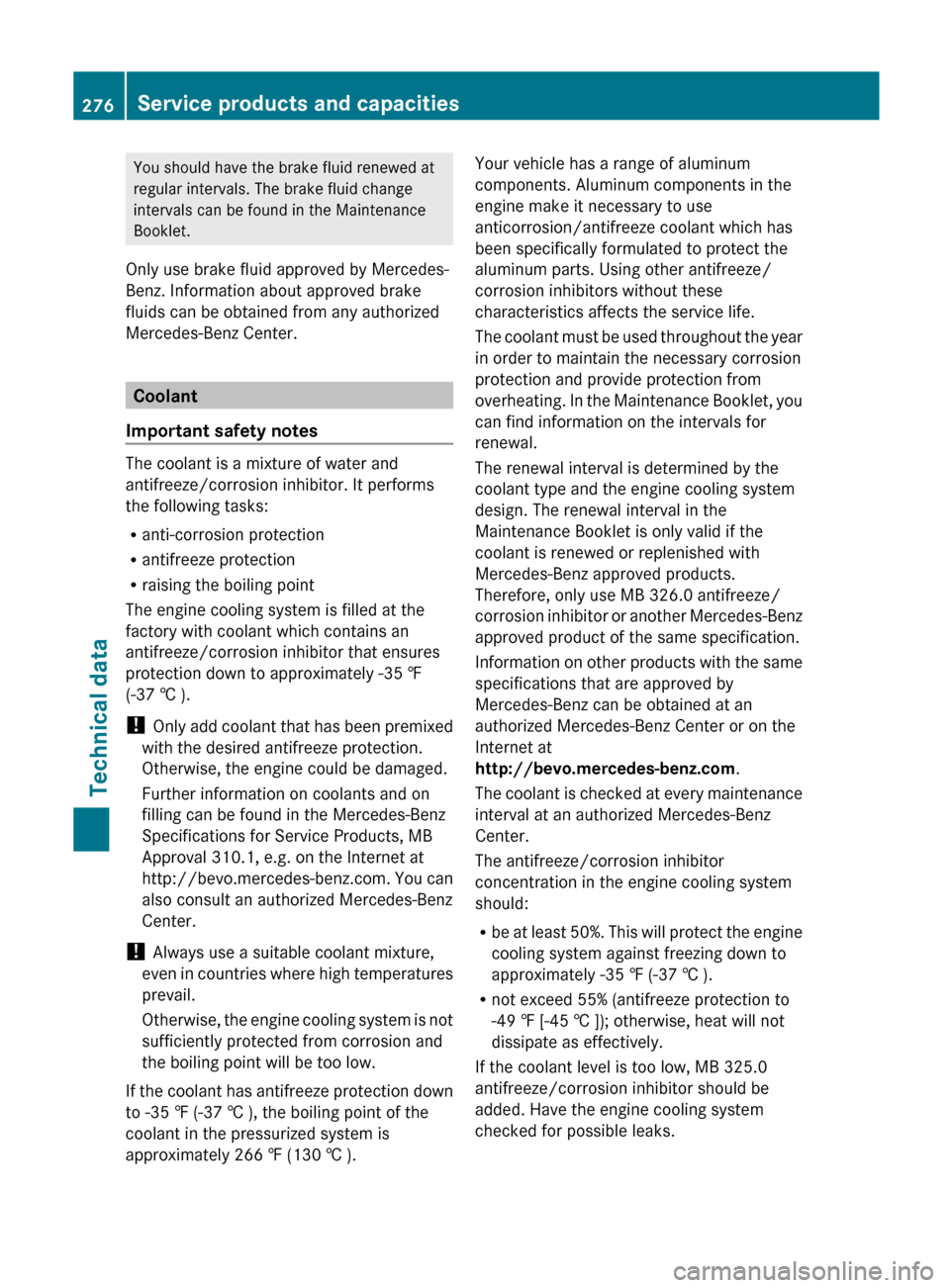
You should have the brake fluid renewed at
regular intervals. The brake fluid change
intervals can be found in the Maintenance
Booklet.
Only use brake fluid approved by Mercedes-
Benz. Information about approved brake
fluids can be obtained from any authorized
Mercedes-Benz Center. Coolant
Important safety notes The coolant is a mixture of water and
antifreeze/corrosion inhibitor. It performs
the following tasks:
R
anti-corrosion protection
R antifreeze protection
R raising the boiling point
The engine cooling system is filled at the
factory with coolant which contains an
antifreeze/corrosion inhibitor that ensures
protection down to approximately -35 ‡
(-37 † ).
! Only add
coolant that has been premixed
with the desired antifreeze protection.
Otherwise, the engine could be damaged.
Further information on coolants and on
filling can be found in the Mercedes-Benz
Specifications for Service Products, MB
Approval 310.1, e.g. on the Internet at
http://bevo.mercedes-benz.com. You can
also consult an authorized Mercedes-Benz
Center.
! Always use a suitable coolant mixture,
even in countries where high temperatures
prevail.
Otherwise, the engine cooling system is not
sufficiently protected from corrosion and
the boiling point will be too low.
If the coolant has antifreeze protection down
to -35 ‡ (-37 † ), the boiling point of the
coolant in the pressurized system is
approximately 266 ‡ (130 † ). Your vehicle has a range of aluminum
components. Aluminum components in the
engine make it necessary to use
anticorrosion/antifreeze coolant which has
been specifically formulated to protect the
aluminum parts. Using other antifreeze/
corrosion inhibitors without these
characteristics affects the service life.
The
coolant
must be used throughout the year
in order to maintain the necessary corrosion
protection and provide protection from
overheating. In the Maintenance Booklet, you
can find information on the intervals for
renewal.
The renewal interval is determined by the
coolant type and the engine cooling system
design. The renewal interval in the
Maintenance Booklet is only valid if the
coolant is renewed or replenished with
Mercedes-Benz approved products.
Therefore, only use MB 326.0 antifreeze/
corrosion inhibitor or another Mercedes-Benz
approved product of the same specification.
Information on other products with the same
specifications that are approved by
Mercedes-Benz can be obtained at an
authorized Mercedes-Benz Center or on the
Internet at
http://bevo.mercedes-benz.com.
The coolant is checked at every maintenance
interval at an authorized Mercedes-Benz
Center.
The antifreeze/corrosion inhibitor
concentration in the engine cooling system
should:
R be at least 50%. This will protect the engine
cooling system against freezing down to
approximately -35 ‡ (-37 † ).
R not exceed 55% (antifreeze protection to
-49 ‡ [-45 † ]); otherwise, heat will not
dissipate as effectively.
If the coolant level is too low, MB 325.0
antifreeze/corrosion inhibitor should be
added. Have the engine cooling system
checked for possible leaks. 276
Service products and capacities
Technical data
Page 279 of 284
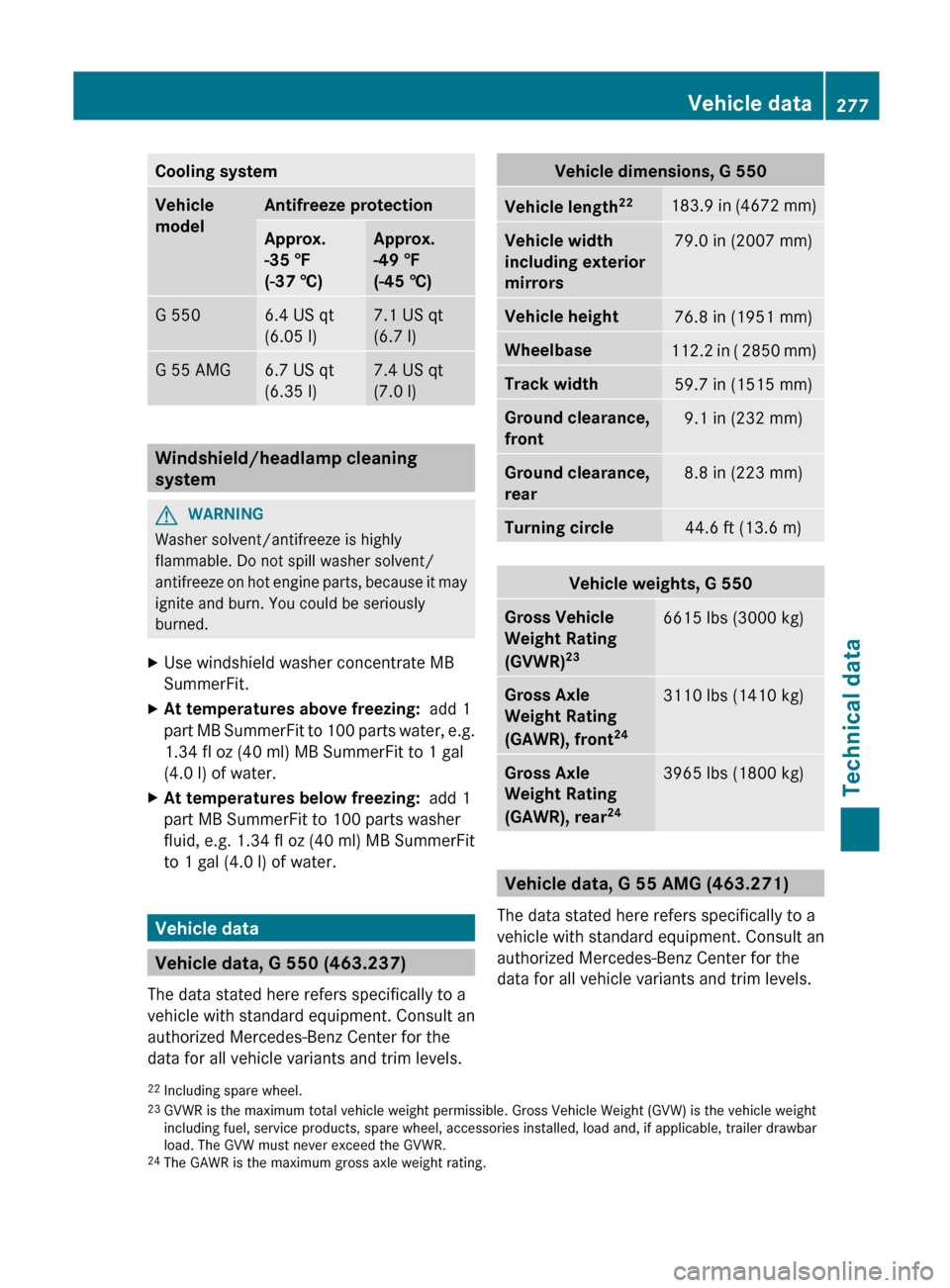
Cooling system
Vehicle
model Antifreeze protection
Approx.
-35 ‡
(-37 †) Approx.
-49 ‡
(-45 †)
G 550 6.4 US qt
(6.05 l) 7.1 US qt
(6.7 l)
G 55 AMG 6.7 US qt
(6.35 l) 7.4 US qt
(7.0 l)
Windshield/headlamp cleaning
system
G
WARNING
Washer solvent/antifreeze is highly
flammable. Do not spill washer solvent/
antifreeze on
hot engine parts, because it may
ignite and burn. You could be seriously
burned.
X Use windshield washer concentrate MB
SummerFit.
X At temperatures above freezing: add 1
part MB
SummerFit to 100 parts water, e.g.
1.34 fl oz (40 ml) MB SummerFit to 1 gal
(4.0 l) of water.
X At temperatures below freezing: add 1
part MB SummerFit to 100 parts washer
fluid, e.g.
1.34 fl oz (40 ml) MB SummerFit
to 1 gal (4.0 l) of water. Vehicle data
Vehicle data, G 550 (463.237)
The data stated here refers specifically to a
vehicle with standard equipment. Consult an
authorized Mercedes-Benz Center for the
data for all vehicle variants and trim levels. Vehicle dimensions, G 550
Vehicle length
22 183.9 in
(4672 mm) Vehicle width
including exterior
mirrors
79.0 in (2007 mm)
Vehicle height
76.8 in (1951 mm)
Wheelbase
112.2 in ( 2850 mm)
Track width
59.7 in (1515 mm)
Ground clearance,
front
9.1 in (232 mm)
Ground clearance,
rear
8.8 in (223 mm)
Turning circle
44.6 ft (13.6 m)
Vehicle weights, G 550
Gross Vehicle
Weight Rating
(GVWR)
23 6615 lbs (3000 kg)
Gross Axle
Weight Rating
(GAWR), front
24 3110 lbs (1410 kg)
Gross Axle
Weight Rating
(GAWR), rear
24 3965 lbs (1800 kg)
Vehicle data, G 55 AMG (463.271)
The data stated here refers specifically to a
vehicle with standard equipment. Consult an
authorized Mercedes-Benz Center for the
data for all vehicle variants and trim levels.
22 Including spare wheel.
23 GVWR is the maximum total vehicle weight permissible. Gross Vehicle Weight (GVW) is the vehicle weight
including fuel, service products, spare wheel, accessories installed, load and, if applicable, trailer drawbar
load. The GVW must never exceed the GVWR.
24 The GAWR is the maximum gross axle weight rating. Vehicle data
277Technical data Z
Page 280 of 284
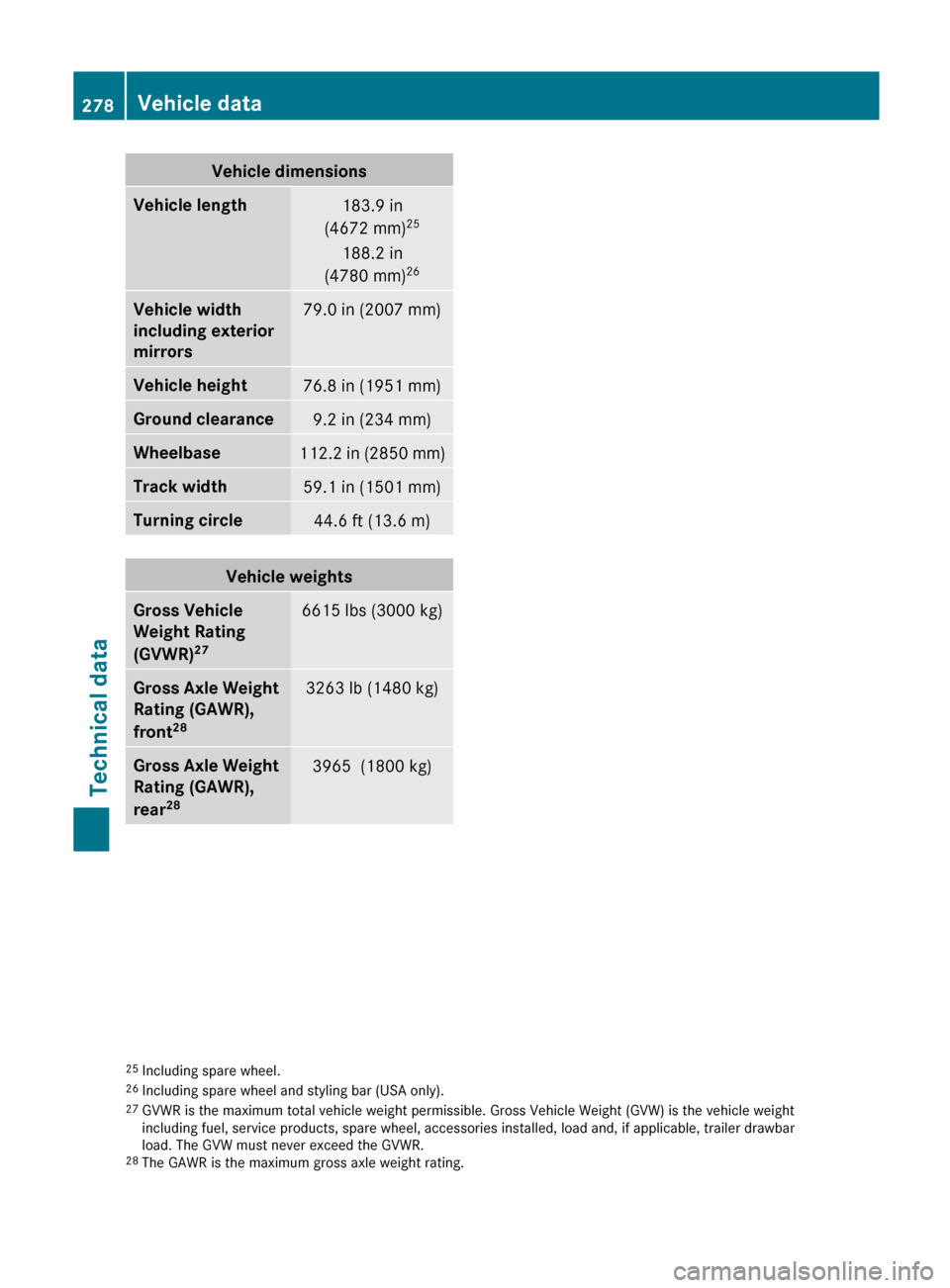
Vehicle dimensions
Vehicle length
183.9 in
(4672 mm) 25
188.2 in
(4780 mm) 26Vehicle width
including exterior
mirrors
79.0 in (2007 mm)
Vehicle height
76.8 in (1951 mm)
Ground clearance
9.2 in (234 mm)
Wheelbase
112.2 in (2850 mm)
Track width
59.1 in (1501 mm)
Turning circle
44.6 ft (13.6 m)
Vehicle weights
Gross Vehicle
Weight Rating
(GVWR)
27 6615 lbs (3000 kg)
Gross Axle Weight
Rating (GAWR),
front
28 3263 lb (1480 kg)
Gross Axle Weight
Rating (GAWR),
rear
28 3965 (1800 kg)
25
Including spare wheel.
26 Including spare wheel and styling bar (USA only).
27 GVWR is the maximum total vehicle weight permissible. Gross Vehicle Weight (GVW) is the vehicle weight
including fuel, service products, spare wheel, accessories installed, load and, if applicable, trailer drawbar
load. The GVW must never exceed the GVWR.
28 The GAWR is the maximum gross axle weight rating.278
Vehicle dataTechnical data